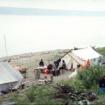Spruce
As food
Spruce gum, dzèh kwan' (G) dzih drinh' (T), is the hard, older kind of tree sap or pitch, with a red or rose colour. It can be picked year round from the trees with a knife, stick or fingers. It can then be chewed like a piece of gum. Both the gum and the juice it produces can be swallowed as you chew. Spruce gum was commonly given to children as a treat when out in the bush cutting wood or picking berries.
As medicine



